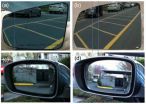(Press-News.org) ANN ARBOR, Mich. — When researchers sequence the RNA of cancer cells, they can compare it to normal cells and see where there is more RNA. That can help lead them to the gene or protein that might be triggering the cancer.
But other than spotting a few known instigators, what does it mean? Is there more RNA because it's synthesizing too quickly or because it's not degrading fast enough? What part of the biological equilibrium is off?
After more than a decade of work, researchers at the University of Michigan Comprehensive Cancer Center have developed a technique to help answer those questions.
The method involves a compound called bromouridine, which can be used to tag or label newly created RNA. Researchers apply the bromouridine for 30 minutes then isolate the RNA to see where the new RNA was made. They call this process Bru-Seq.
On the other hand, the researchers can follow up the bromouridine labeling with a rinse with the chemical uridine for different periods of time. They call this BruChase-Seq because the uridine chases away the newly made RNA so they can look at how the RNA ages over the course of one hour, two hours or six hours. In other words, is the RNA degrading like it's supposed to?
"We can see the whole pattern of all the RNA that's synthesized and all the RNA that's stable vs. degrading. We can sort it out in terms of synthesis and stability and see if a particular RNA is more stable in the cancer cell than the normal cell or if it is taking longer to degrade in the cancer cell than in the normal cell," says study author Mats Ljungman, Ph.D., associate professor of radiation oncology at the U-M Medical School.
"With our technique, we're adding 10-fold more depth to the picture of how genes are expressed," he adds.
Ljungman is part of the Cancer Center's new Translational Oncology Program, which brings together cancer researchers from across the University of Michigan to speed the translation of basic science into clinical trials and new treatment opportunities for patients.
The Cancer Center is currently using gene sequencing techniques to help match advanced cancer patients with potential clinical trial opportunities based on the make-up of their tumor.
In addition to helping with cancer sequencing, Ljungman sees potential for this new technique to help with identifying diseases such as diabetes or inflammation. In the paper describing the technique, published online in Proceedings of the National Academy of Sciences, the researchers describe how they used it to understand an inflammatory response in cells. The researchers have also used the technique to test blood samples.
With a great deal more investigation, Ljungman envisions that one day the test could potentially be offered to people visiting their doctor as a way to monitor changes in the RNA.
"If something is significantly changed from one test to the next, it could be a red flag or an early warning sign of disease. That would be the broadest use of this technology," Ljungman says.
###
Additional U-M authors: Michelle T. Paulsen, Artur Veloso, Jayendra Prasad, Karan Bedi, Emily A. Ljungman, Ya-Chun Tsan, Ching-Wei Chang, Brendan Tarrier, Joseph G. Washburn, Robert Lyons, Daniel R. Robinson, Chandan Kuman-Sinha, Thomas E. Wilson
Funding: U-M Bioinformatics Program, U-M Bioinformatics Council, Will and Jeanne Caldwell Endowed Research Fund of the U-M Comprehensive Cancer Center, U-M School of Public Health, U.S. Department of Defense, Uniting Against Lung Cancer, U-M Nathan Shock Center, U-M Office of the Vice President of Research, National Cancer Institute grant 5R21CA150100, National Institute of Environmental Sciences grant 1R21ES020946, National Human Genome Research Institute grant 1R01HG006786
Disclosure: None
Reference: Proceedings of the National Academy of Sciences, DOI: 10.1073/pnas.1219192110
Resources:
U-M Cancer AnswerLine, 800-865-1125
U-M Comprehensive Cancer Center, www.mcancer.org
Clinical trials at U-M, www.UMClinicalStudies.org/cancer END
New technique sheds light on RNA
U-M researchers develop method that could enhance gene sequencing data
2013-01-28
ELSE PRESS RELEASES FROM THIS DATE:
Study finds energy use in cities has global climate effects
2013-01-28
TALLAHASSEE, Fla. ⎯ The heat generated by everyday energy consumption in metropolitan areas is significant enough to influence the character of major atmospheric circulation systems, including the jet stream during winter months, and cause continental-scale surface warming in high latitudes, according to a trio of climate researchers that includes Ming Cai, a professor in Florida State University's Department of Meteorology.
Led by Guang Zhang, a research meteorologist at Scripps Institution of Oceanography at the University of California, San Diego, the scientists ...
University of Tennessee researcher finds 'first time' could predict sexual satisfaction
2013-01-28
Research conducted by Matthew Shaffer, a doctoral psychology student at UT and C. Veronica Smith, an assistant psychology professor at the University of Mississippi, reveals that the first sexual experience can set the tone for the rest of one's sexual life.
The study is published in the Journal of Sex and Marital Therapy and is the first to look at whether the circumstances of losing one's virginity have lasting consequences.
"The loss of virginity is often viewed as an important milestone in human development, signifying a transition to adulthood," said Shaffer. ...
Majority of Americans support dozens of policies to strengthen US gun laws
2013-01-28
The majority of Americans support a broad array of policies to reduce gun violence, according to a new national public opinion survey conducted by researchers at the Johns Hopkins Bloomberg School of Public Health. These policies include: requiring universal background checks for all gun sales (supported by 89 percent); banning the sale of military-style semiautomatic assault weapons (69 percent); banning the sale of large-capacity ammunition magazines (68 percent); and prohibiting high-risk individuals from having guns, including those convicted of a serious crime as a ...
Phone and mailed interventions significantly increase colorectal cancer screening rates
2013-01-28
PHILADELPHIA—A mailing or phone call to help patients get screened for colorectal cancer significantly increases their chances of actually getting tested, according to a study published in the January issue of Cancer Epidemiology, Biomarkers and Prevention by researchers at the Kimmel Cancer Center at Jefferson.
The research team, led by Ronald E. Myers, Ph.D., Professor and Director of Division of Population Science, Department of Medical Oncology at Thomas Jefferson University, performed a randomized, controlled trial of 945 people aged 50-79 to test the impact of a ...
Stanford researchers break million-core supercomputer barrier
2013-01-28
Stanford Engineering's Center for Turbulence Research (CTR) has set a new record in computational science by successfully using a supercomputer with more than one million computing cores to solve a complex fluid dynamics problem—the prediction of noise generated by a supersonic jet engine.
Joseph Nichols, a research associate in the center, worked on the newly installed Sequoia IBM Bluegene/Q system at Lawrence Livermore National Laboratories (LLNL) funded by the Advanced Simulation and Computing (ASC) Program of the National Nuclear Security Administration (NNSA). Sequoia ...
Smart organizations should also be stupid according to new theory
2013-01-28
"We see functional stupidity as the absence of critical reflection. It is a state of unity and consensus that makes employees in an organisation avoid questioning decisions, structures and visions", says Mats Alvesson. "Paradoxically, this sometimes helps to raise productivity in an organisation."
Together with colleague André Spicer, Mats Alvesson has written an article entitled 'A Stupidity-Based Theory of Organisations', which was recently published in the renowned Journal of Management Studies and has been featured in the Financial Times. In the article, he expounds ...
Progressive optics for side mirrors ends automobile blind spots without distorting view
2013-01-28
WASHINGTON, Jan. 28, 2013—A new optical prescription for automobile side-view mirrors may eliminate the dreaded "blind spot" in traffic without distorting the perceived distance of cars approaching from behind. As described in a paper published today in the Optical Society's (OSA) journal Optics Letters, objects viewed in a mirror using the new design appear larger than in traditional side-view mirrors, so it's easier to judge their following distance and speed.
Today's motor vehicles in the United States use two different types of mirrors for the driver and passenger ...
Pandemic controversies: The global response to pandemic influenza must change
2013-01-28
'Evil' scientists, deadly viruses and terrorist plots are usually the preserve of Hollywood blockbusters. But when it comes to pandemic influenza, it is the stuff of real life. As controversy about research into the H5N1 bird flu virus continues, a new paper argues for a complete overhaul of current approaches to pandemic preparedness.
To Pandemic or Not? Reconfiguring Global Responses to Influenza, by Dr Paul Forster, of the ESRC STEPS Centre, investigates the H1N1 swine flu pandemic of 2009-10 and sets out some vital lessons if we are to prepare for pandemic influenza ...
Fewer people adding salt at the table
2013-01-28
The number of people in England adding salt to food at the table fell by more than a quarter in the five years following a national campaign, according to research published in the British Journal of Nutrition.
In 2003, the UK Food Standards Agency and the Department of Health launched a national salt reduction campaign to raise public awareness of the impact of salt on health and to work with the food industry to reduce the amount of salt in processed foods.
Although previous research found that the national campaign led to an overall reduction in salt intake, this ...
Novel materials: Smart and magnetic
2013-01-28
Novel, smart materials like shape memory alloys very often display so-called glass-like magnetism. Other smart materials with similar properties include those which, when exposed to a magnetic field, change their electrical resistance, known as manganites, or change their temperature, known as magnetocaloric materials. Kaustav Mukherjee and his colleagues from the Consortium for Scientific Research Indore in India studied a key stage in the formation of such a magnetic glass material, called Pr0.5 Ca0.5 Mn0.975 Al0.025 O3, in a paper about to be published in EPJ B.
They ...
LAST 30 PRESS RELEASES:
HKUST Engineering researchers developed a novel photodetector to enhance the performance of on-chip light monitoring
Strategic river sensors could have forewarned of Texas Camp flood disaster
Drone sampling of whale breath reveals first evidence of potentially deadly virus in Arctic
Roman soldiers defending Hadrian’s Wall infected by parasites, study finds
Pinochet’s prisoners were tormented with music but still found solace in it, a new book reveals
Fertility remains high in rural Tanzania despite access to family planning
AI-assisted device can improve autism care access
Kinetic careers
Uncovering how parasitic plants avoid attacking themselves to improve crop resistance
Nanoparticle vaccine strategy could protect against Ebola and other deadly filoviruses
Study finds brain care score can predict risk of stroke across racial groups
Key lung immune cells can intensify allergic reactions
Do hormones explain why women experience more gut pain?
New materials conduct ions in solids as easily as in liquids
Breakthrough of the Year: Renewable energy begins to eclipse fossil fuel-based sources
LLM use is reshaping scientific enterprise by increasing output, reducing quality and more
Introducing LightGen, a chip for ultra-fast, ultra-efficient generative AI
Astronomers see fireworks from violent collisions around nearby star
ACC/AHA issue new guideline on managing congenital heart disease in adults
Cosmic crash caught on camera
Is talented youth nurtured the wrong way? New study shows: top performers develop differently than assumed
Ants: An untapped resource in the development of antibiotics?
Archaeologists use AI to create prehistoric video game
Mitochondria migrate toward the cell membrane in response to high glucose levels
Tiny viral switch offers hope against drug-resistant bacteria
Most parents aware of early peanut introduction guidelines, but confused about details
HPV vaccine can protect against severe lesions of the vulva and vagina
Virtual care provision and emergency department use among children and youth
Quadrivalent HPV vaccine and high-grade vulvovaginal lesions
Insights into dry eyes gained from stem cell-derived tear glands
[Press-News.org] New technique sheds light on RNAU-M researchers develop method that could enhance gene sequencing data


